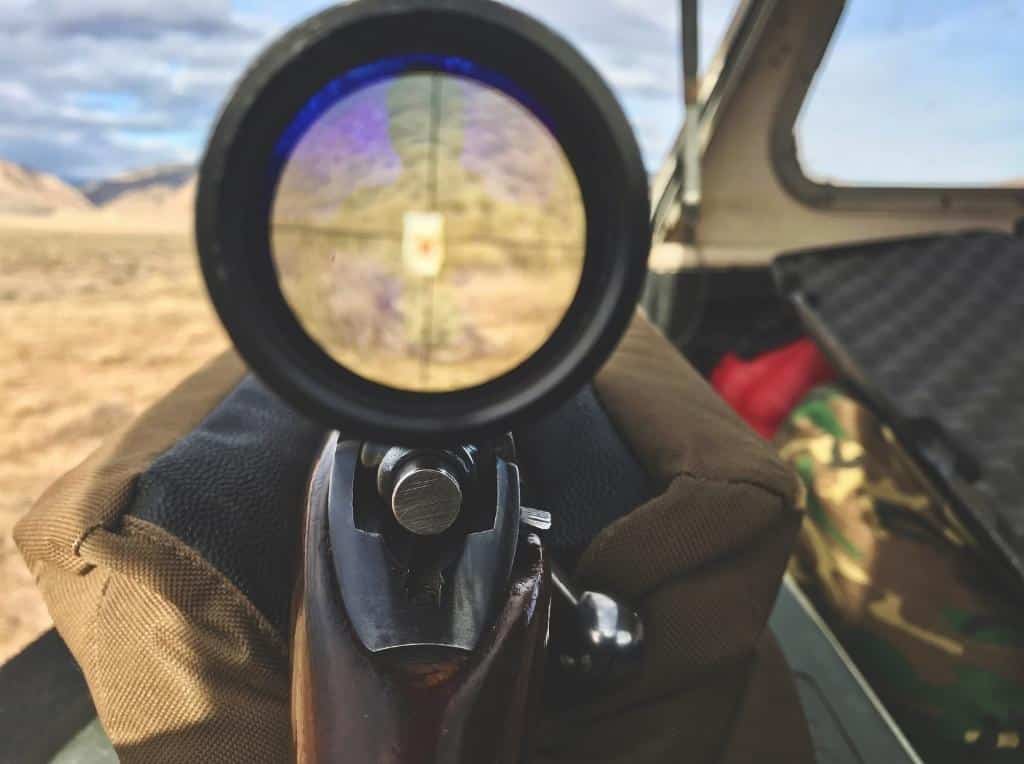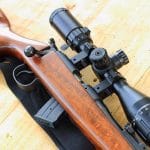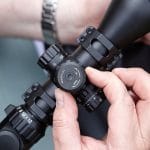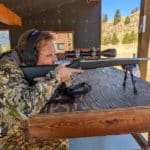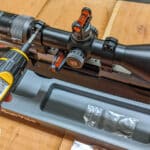It’s an exciting time when you finally put sights on that deer that you’ve been stalking for the past several hours. You’ve practiced proper trigger control and know how to steady your rifle to maximize your chances of hitting the deer in the kill zone.
But how far away is that animal? And how far is your bullet going to drop?
In my opinion, the best hunting zero technique is the Maximum Point Blank Range zero. MPBR lets you place your bullet into an animal’s vital zone at short to long ranges without requiring any field math, Kentucky windage, or fiddling with your sights.
It’s a dismal feeling when you think you’ve hit an animal with a well-placed shot only to discover, after many hours and much tracking, that you hit it in the gut and caused a slow, painful death.
Accidentally shooting above the buck is better but can still cause the animal to bolt, potentially ruining your hunt.
And, while rangefinders are amazing tools, you don’t always have the time or ability to figure out that animal’s exact range and compensate accordingly.
But what does “Maximum Point Blank Range” mean anyway? And how can you use that to zero your rifle?
Why Use Maximum Point Blank Range Zeroing for Hunting?
If there’s one word I’d use to describe hunting with the Maximum Point Blank Range (MPBR) zero, that word is confidence.
You’ll be able to confidently take the shot on your game at short, medium, and even long ranges. Without using a rangefinder!
How does giving your rifle an MPBR zero accomplish this?
Why, it’s in the name: it maximizes your rifle’s point-blank range.
Many people use the term “point-blank” to refer to a target close enough you have almost no chance of missing. This common usage is not entirely correct, though they’ve got the right idea!
Properly speaking, point-blank range is the distance at which you can aim without having to compensate for bullet drop.
MPBR is a sighting technique that applies this idea to the specific animal (or target) you want to hunt. Aim for the center of the kill zone, pull the trigger, and you’ll make a devastating shot at 50, 100, or even 200 yards!
You may have but a fleeting moment to line your sights up on that moose or bear and take the shot. Spend some time at the range sighting in your gun and you’ll be able to take advantage of that moment.
How the Maximum Point Blank Range Zero Works
As you’re aware, bullets drop. They have an arc to their flight. Always a downward arc, technically, due to gravity.
Your sights, whether they’re iron sights, a red dot, or a telegraphic sight, do not arc. They point in a solid line, off to eternity.
Keep this line in mind.
Many people sight in their rifles at 100 yards and expect to hit below that at farther ranges. In this case, that line from the scope points slightly downward relative to the gun’s bore. It intersects with the bullet’s arc at a single known point, 100 yards.
This is fine for range purposes but we can do better.
MPBR points the sight’s line at an angle to intersect the bullet’s arc twice. If we had a chart with the sight-held level, it would look like the bullet’s curve would be rising at the first intersection and falling at the second intersection.

That first intersection is the Near Zero and the far intersection is the Far Zero. But that’s not all MPBR gives you.
Because MPBR is calculated using your chosen target’s vital zone size, the bullet will never rise (relative to your sights) enough to leave that vital zone.
You’ll hit high when the animal is between the Near Zero and the Far Zero, but never too high! (So long as you aim at the dead center of the vital area, of course.)
But the Far Zero isn’t your shooting limit. The bullet will continue to drop, but it’ll take some time for the bullet to arc downward enough to leave the vital zone.
The distance the bullet will travel before dropping out of the target area is the “maximum” part of “Maximum Point Blank Range.” It can be 40 yards past the Far Zero or more.
Using this zero, your maximum point-blank range will be 200 yards or more, depending on your rifle, ammo, and target.
How to Sight Your Rifle with a Maximum Point Blank Range Zero
So, setting up your rifle to take advantage of the MPBR hunting zero does take some math and even some research, but it’s all pretty easy.
Here’s what you need to know:
- Your target’s vital area size
- Your rifle sight’s height over the bore
- Your ammo’s initial velocity
- Your projectile’s ballistic coefficient
Let’s tackle those in order and then put them all together.
Target Size
You need to know how large a target you want to hit, measured from top to bottom. For a small deer’s vital area, this is roughly eight inches in height.
You’ll have to look up the kill zone yourself if you’re hunting another animal. You can also measure a paper target’s height and use that number.
Measure the total size of the target, not the distance from the center to the edge.
Sight Height Over Bore
You know how bolt-action rifles tend to have sights close to the barrel while modern sporting rifles such as ARs tend to have iron sights that stand several inches above the bore?
This actually works to the MSR’s advantage when it comes to MPBR!
Find the distance from your sight’s centerline to the middle of the bore. This is the sight height measurement. It’s different from gun model to gun model. For example, most AR-15s have an iron sight height over bore of 2.6″.
A slightly less precise yet still useful method of determining your sight’s height over bore is to measure from the middle of the bolt or barrel to the middle of the scope.

If your rifle has a tapered barrel and iron sights, Brownells has a sight height calculator that can help you.
Projectile Velocity
Here’s where you need to grab a chronograph if you want to be truly accurate. You need to know your ammo’s initial velocity—the more accurate, the better. If you need to, you can use your ammo manufacturer’s data for this, though it won’t be accurate to your gun.
Variances in barrel manufacturing can affect velocity. So can atmospheric factors and barrel length. If these don’t match up with the manufacturer’s tests, then your velocity won’t be accurate.
A difference of 50 fps can result in an MPBR reading difference of 6 yards, which doesn’t render the calculation ineffectual but does add up.
Ballistic Coefficient (and Drag Function)
You must also know your specific projectile’s ballistic coefficient (BC). This measurement of the bullet’s shape helps shooters estimate the bullet’s ability to buck the wind. It’s complicated to calculate and changes based on the bullet’s velocity.
Thankfully, you can just get this off your bullet manufacturer’s website with little fuss.
Another factor, the drag function, also affects the calculations. It has to do with the bullet’s shape, such as the ogive’s shape (curved point) and the boat tail’s angle.
If the bullet maker shares this information, it’ll be a G followed by a number. G1 is the most common, though you’ll likely notice G7 on some very low-drag bullets.
Some manufacturers, such as Hornady, give you several BCs and specify which drag function to use. Make sure to match the BC to the drag function.
Don’t see a drag function?
Just use G1. It’s the most popular.
Putting it All Together and Calculating Maximum Point Blank Range
Now here’s the part you’ve been dreading: Doing the math.
Just kidding!
You can use an online calculator to figure out your MPBR.
Choose your drag function and enter the measurements you picked out above.
If you’re feeling spicy, you can click the box to enable atmospheric correction, though this will have a minor effect on your final results.
Click “Calculate Point Blank Range” and you’ll have five numbers:
- Near Zero
- Far Zero
- Minimum PBR
- Maximum PBR
- Sight-in at 100 yds
Maximum PBR will give you the farthest you can engage your target and still make a kill shot, provided you do your part well.
Near Zero, Far Zero, and Sight-in at 100 yds give you what you need to sight in your rifle for the Maximum Point Blank Range zero.
Sighting In Your Rifle with the Maximum Point Blank Range Zero Technique Step-by-Step
- Write down the results from the calculator and keep the info with you as you go to the range.
- Bring a target that’s good for sighting in rifles. I like to use those with 1″ squares so I don’t have to measure how far away my bullets hit.
- If this is your first time sighting in your rifle, then you will need to bore sight your rifle to get on paper before you throw lead down range.Otherwise, head to the shooting range!
- Look at those three numbers, the Near Zero, Far Zero, and 100 yards Sight-in.Which one is the closest to an easy-to-use round number?Choose the most convenient of the three and set up a target at that distance. This is likely the Near Zero or the 100-yard Sight-in.For either the Near Zero or the Far Zero, you want the bullet hole to be at the exact point of aim.For the 100-yard Sight-in, you want the point of impact to be the calculated distance above (or maybe below) the point of aim.
- Aim at the bullseye and shoot slow, controlled groups. I start with three-shot groups at first, then five-shot groups when I’m confirming that the rifle is sighted in.
- Shoot a group, observe the results, adjust your sights, and repeat until you’re on target.
- Now, test your rifle at various ranges.
You’ll hit below the bullseye up to your Near Zero, above it until the Far Zero, and below it past there, all the while staying in your target area.
Congratulations! You’re ready to hunt with full confidence in your ability to deliver a one-shot kill.
Example Maximum Point Blank Range Zero Calculations
While it’s best to enter information specific to your rifle and ammunition into the calculator, here are a few example calculations based on common hunting calibers.
Remington 700 Chambered in .270 Winchester
.270 Winchester is a venerable cartridge that’s effective against almost every game animal in North America. Many Remington 700s are chambered in .270, making this a rather common combo.
Out of a 24″ barrel, Hornady’s American Whitetail 140 gr InterLock bullet has an initial velocity of 2,940 fps with a ballistic coefficient of .486 and a G1 draft factor.
The average Remington 700 scope’s height over bore is 1.68″.
We’ll use a deer’s vitals for our target size.
This gives you a Near Zero of 26 yards, Far Zero of 281 yards, and MPBR of 330 yards. The bullet will hit 3.2″ high at 100 yards.
AR-15 Chambered in 5.56 NATO
AR-15s have become standard rifles for varmint hunting and even deer hunting in some areas. You’ll want to use a heavy-for-caliber bullet when hunting with 5.56 NATO or .223 Remington but that type of ammo is commonly available now.
So, with a sight height of 2.6″ and using Hornady BLACK ammo with 75 gr InterLock bullets, you can get a .230 BC bullet (G1 draft factor) moving at 2,321 fps.
This is good enough for coyote hunting, so we’ll use a vital zone of 5″.
With this data, you’ll have a Near Zero of 35 yards, Far Zero of 183 yards, and MPBR of 211 yards. Your bullet will hit 2.42″ high at 100 yards.
Your Average .308 Winchester Hunting Rifle
Open up most ballistic programs and you’ll find a 1.5″ scope height as standard. Grab a bolt-action rifle with a not-huge scope, or even some semi-auto rifles, and that will match up close enough.
Load up that .308 rifle with some Hornady American Whitetail 165 gr InterLocks and you have a fine hunting rifle. How does its MPBR hold up, though?
Use a velocity of 2,700 fps, .435 BC (G1 draft factor), and point the rifle at a large deer or small sheep for a target size of 12″.
You’ll get a Near Zero of 17 yards, Far Zero of 299 yards, and MPBR of 352 yards!
That .30-cal bullet will hit 4.8″ high at 100 yards.
This sounds high, but the Maximum Point Blank Range is working as intended. You’ll hit high out to almost 300 yards, but never more than 6″ high!
When to Use Other Hunting Zero Techniques
As much as I like using the Maximum Point Blank Range zero for hunting small and large game, it’s not perfect for every situation.
You may always hunt at the same known distance, such as from a hunting stand to the edge of a field. This will let you sight in your rifle so your point of aim and point of impact intersect at exactly that distance.
On the other hand, people who are hunting at very long ranges won’t see any benefit from using MPBR. It’s only useful for that indicated maximum distance. Then afterward, you’ll have to calculate bullet drop.
You might as well sight in that firearm with a more convenient zero.
And if you’re only going to shoot at paper or steel targets at specific ranges, then you’ll want the precision of a more specific zero. Especially when in a shooting competition where accuracy matters.
Also, the MPBR zero is designed for fixed elevation sights or sights where it’s a pain to adjust the elevation. If you have sights that are designed to be adjusted to compensate for range, then using an MPBR zero will muddy the calculations.
Examples are some high-end scopes and AR-15 iron sights with the elevation drum. Sight those in as recommended by the manufacturer and you won’t need to use the MPBR zero!
Conclusion
Calculating your Maximum Point Blank Range will give you several zeros you can use to dial in your rifle for hunting at various ranges.
Best of all, you won’t need any range measuring or elevation adjustment. Aim at the center of your prey’s vital zone and fire. You’ll hit right where you need to hit!
This is perfect for hunting in situations where that pesky deer can show up 50 yards away or 200. It’s also good for smaller targets.
Even some 3-gun shooters can take advantage of the technique.
Most of my hunting rifles are zeroed according to their Maximum Point Blank Range.
How do you zero your hunting rifles?

